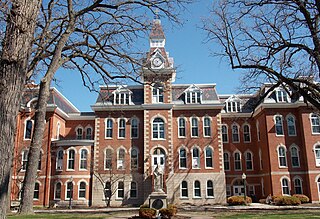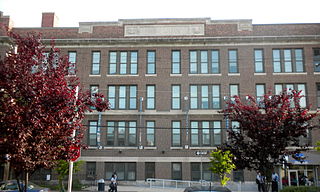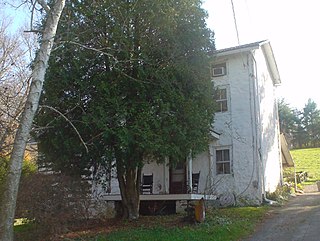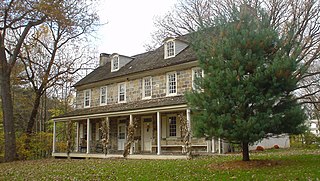
Thornbury Township is a township in Chester County, Pennsylvania, United States. The population was 3,017 at the 2010 census. It is adjacent to, and was once joined with, Thornbury Township, Delaware County.

The Institute for Colored Youth was founded in 1837 in Philadelphia, Pennsylvania, United States. It became the first college for African-Americans in the United States, although there were schools that admitted African Americans preceding it. At the time, public policy and certain statutory provisions prohibited the education of blacks in various parts of the nation and slavery was entrenched across the south. It was followed by two other black institutions— Lincoln University in Pennsylvania (1854), and Wilberforce University in Ohio (1856). The second site of the Institute for Colored Youth at Ninth and Bainbridge Streets in Philadelphia was added to the National Register of Historic Places in 1986. It is also known as the Samuel J. Randall School. A three-story, three-bay brick building was built for it in 1865, in the Italianate-style After moving to Cheyney, Pennsylvania in Delaware County, Pennsylvania its name was changed to Cheyney University.

Harriton House, originally known as Bryn Mawr, is an historic house which is located on the Philadelphia Main Line, and was most famously the residence of Founding Father Charles Thomson, the secretary of the Continental Congress.

Cheyney is an unincorporated community that sits astride Chester and Delaware counties in the U.S. state of Pennsylvania. It corresponds to the census-designated place known as Cheyney University, which had a population of 988 at the 2010 census. It is the home of Cheyney University of Pennsylvania. The university derives its name from George Cheyney's Farm, which became the current campus of Cheyney University in 1902. George Cheyney's Farm and the surrounding area was part of the original land grant given to William Penn in 1681.

Prospect House, known also as just Prospect, is a historic house on the Princeton University campus in Princeton, Mercer County, New Jersey, United States. Built in 1851, it is a fine example of the work of architect John Notman who helped popularize Italianate architecture in America. Notable residents include Woodrow Wilson during his tenure as president of the university. The building now serves as a faculty club. It was designated a National Historic Landmark in 1985 for its architecture and historic associations.

The Pennsylvania School for the Deaf is the third-oldest school of its kind in the United States. Its founder, David G. Seixas (1788–1864), was a Philadelphia crockery maker-dealer who became concerned with the plight of impoverished deaf children who he observed on the city's streets. The current school building is listed by the National Register of Historic Places, and two former campuses are similarly recognized.

Ambrose Hall, located in Davenport, Iowa, United States, is the first building constructed on the campus of St. Ambrose University. It was listed on the National Register of Historic Places in 1977.

White Horse Farm, also known as the Elijah F. Pennypacker House, is a historic home and farm located in Schuylkill Township, Chester County, Pennsylvania. The original section was built around 1770. In the 19th century, it was the home of abolitionist Elijah F. Pennypacker and served as a station on the Underground Railroad. The farm was added to the National Register of Historic Places in 1987.

Mastery Charter School Thomas Campus, formerly the George C. Thomas Junior High School, is a secondary charter school located in the south section of Philadelphia, Pennsylvania. It is run by Mastery Charter Schools. It is located at the intersection of 9th and Johnston Streets just north of the South Philadelphia Sports Complex. Nearby are the residential neighborhoods of Marconi Plaza, Lower Moyamensing, and Packer Park; the recreational parkland of FDR Park; and the historical and new business-development center of the Philadelphia Naval Shipyard. The school is located within the boundaries of the Sports Complex Special Services District, directly on the Oregon Avenue urban corridor of small shops and restaurants anchored by larger shopping plazas on the east and west end of Oregon Avenue, and near the revitalized commercial area of Passyunk Avenue. It shares a site with the D. Newlin Fell School.

The John Cheyney Log Tenant House and Farm, also known as the Thomas Huston Farm, is an historic American home and associated buildings that are located in Cheyney, Delaware County, Pennsylvania.

Collen Brook Farm, also known as Collenbrook, is a historic home and associated buildings located in Upper Darby, Delaware County, Pennsylvania. The complex includes three contributing buildings: a farmhouse, a granite spring house, and stone and frame carriage house. The house is a 2+1⁄2-story, vernacular stone residence with a Georgian plan and consisting of three sections. The oldest section was built around 1700, with additions made in 1774, and 1794. It was the home of noted educator and political leader George Smith (1804–1882).

Abbeville, also known as Mt. Pleasant, is a historic home located at 1140 Columbia Avenue in Lancaster Township, Lancaster County, Pennsylvania.

Miller's House at Spring Mill is a historic building in the Spring Mill section of Whitemarsh, Montgomery County, Pennsylvania, United States. Located about 200 feet from where Spring Mill Creek empties into the Schuylkill River, it is about a quarter-mile southeast of the Borough of Conshohocken.

Mechanicsville School is a former school building located in the Village of Mechanicsville neighborhood of Philadelphia, Pennsylvania. It was built in 1866–1867, and is a one-story, three-bay, vernacular stone building coated in stucco. It has a gable roof with wood cornice and brick chimney.

Germantown Grammar School, also known as Lafayette Grammar School and Opportunities Industrial Center, Inc., are two historic school buildings located in the Germantown neighborhood of Philadelphia, Pennsylvania.

Twining Farm, also known as the David and Elizabeth Twining Farm, is a historic home and farm located at Newtown Township, Bucks County, Pennsylvania. The stone farmhouse was built in two stages. They are a 2+1⁄2-story, stone eastern section, with a later three-bay, 2+1⁄2-story western addition built in 1832. A frame wing and bow window were added about 1940. Also on the property are a contributing stable, chicken house, and bank barn complex. The farm was featured in three of four Newtown farmscape paintings by noted artist Edward Hicks (1780-1849). Hicks had resided for 10 years at the farm as the foster son of Elizabeth and David Twining.

Riverside Farm, also known as Evermay-on-the-Delaware, is a historic hotel located near Erwinna, Tinicum Township, Bucks County, Pennsylvania. The house is a 3 1/2-story, six bay, frame vernacular dwelling with Greek Revival and Italianate style influences. The oldest section of the main house was built in the late 18th century as a two-story, three bay frame structure. Additions to the house occurred between about 1870 and 1883, when it took its present form. A stairwell addition was built in 1982. The front facade features a one-story, flat roofed porch. Also on the property are a contributing tenant house, carriage house, shed, and ice house. The house was built as a private dwelling, then converted for use as a hotel and resort starting about 1870. It operated as an inn until 1930. It reopened in 1982 as a bed-and-breakfast known as EverMay On-The-Delaware. But was closed in 2005 and now operates as a private residence.

Squire Cheyney Farm is a historic farm and national historic district located in Thornbury Township, Chester County, Pennsylvania. The district encompasses two contributing buildings, three contributing sites, one contributing structure, and contributing object. They are the farmhouse, barn, ruins of a granary, remains of an ice house, a spring house (1799), stone retaining wall, and family cemetery. The house was built in four periods, with the oldest dated to about 1797. The oldest section is a 2 1/s-story, three bay, stuccoed stone structure with a gable roof. The additions were built about 1815, about 1830, and about 1850, making it a seven-bay-wide dwelling. It is "L"-shaped and has a slate gable roof. During the American Revolution, Thomas "Squire" Cheyney [II] informed General George Washington during the Battle of Brandywine that the British were flanking him to the north. He was later appointed to the Pennsylvania Ratifying Convention to ratify the United States Constitution. The site is now a township park known as Squire Cheyney Farm Park.

Joseph Walker House, also known as Wayne's Quarters, is a historic home located in Tredyffrin Township, Chester County, Pennsylvania. The house was built in four sections, with the oldest dated to about 1757. It is the three bay at the western end of the eleven bay house, and is a two-story, double pile stone structure. The additions took place about 1820, about 1870, and about 1920. It was renovated in 1950 and Colonial Revival details added. During the American Revolution the house served as headquarters for General Anthony Wayne in late-1777 and early-1778, during the encampment at Valley Forge.

The Joseph Gregg House is an historic home that is located in Kennett Township, Chester County, Pennsylvania.























